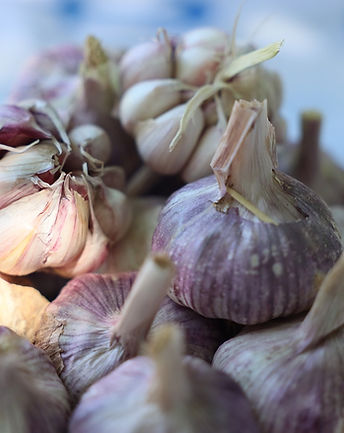
Features and Production
Ula Garlic's journey from soil
to table



Grown in the fertile soils of Mugla, Ula Garlic is meticulously cultivated in organically rich, loamy, sandy soil. Every stage, from planting to harvest, is carried out in harmony with nature. Below, you can find the production journey of this unique product.
Ula garlic contains approximately 6.6 grams of carbohydrates per 100 grams. The majority of the total carbohydrates are galactose. The mannose content in Ula garlic is another chemical composition that distinguishes it from other garlics. Garlic produced in Turkiye contains sucrose, glucose, and fructose as carbohydrates, with fructose being the primary component, while Ula garlic contains fructose, mannose, glucose, and galactose, with galactose being the primary component.
Ula garlic grows well in loamy, sandy soils with high organic matter. Fields where garlic will be planted are plowed deeply with a tractor plow in September and October. In November, well-rotated farm manure is spread on the soil and worked in with a rotary tiller to a depth of 10-15 cm. To protect the garlic planted during the winter months, a 1.2-meter-wide bank is constructed. In November, clove garlic is planted 2-3 cm deep, 10-15 cm apart.
Weeding and soil loosening are carried out in February and March. Root development is encouraged with a second hoeing in April. Drip irrigation is applied during dry periods. Harvest time begins when yellowing begins in early June. After harvest, the garlic is dried in the shade, and the seeds are stored separately.
Traditional Garlic Storage Methods in Ula
Garlic is an essential part of Ula’s culinary culture and remains a staple in local kitchens throughout the year. Although the harvest takes place at the end of May, the need for garlic continues during the winter months. To prevent sprouting and preserve aroma and flavor, two traditional storage methods are commonly practiced in Ula.
Storing Peeled Garlic in Olive Oil
The first method involves peeling the garlic cloves one by one, drying them thoroughly, and storing them in a jar filled with olive oil.
With this method:
• The garlic does not sprout,
• Its aroma and flavor remain intact,
• The olive oil gently absorbs the garlic’s aroma, adding value and depth to your cooking.
Freezing Garlic with the Skin On
The second method is to freeze the garlic with its skin intact.
The advantages of this method include:
• Once thawed, the cloves are as easy to peel as fresh garlic,
• The texture and flavor are preserved,
• It offers a practical solution for winter months.
Natural Solutions Rooted in Local Knowledge
At the Ula Garlic Association, we apply and support these time-tested methods, passed down through generations by local producers and Ula residents. Our own trials confirm that both techniques preserve the garlic’s aroma and flavor, making them reliable and effective storage practices.
Accessing Genuine Purple Ula Garlic
Purple Ula Garlic with geographical indication can be obtained through our association. By choosing Ula garlic, you not only enjoy an authentic local product but also help support regional producers and contribute to local economic development.
